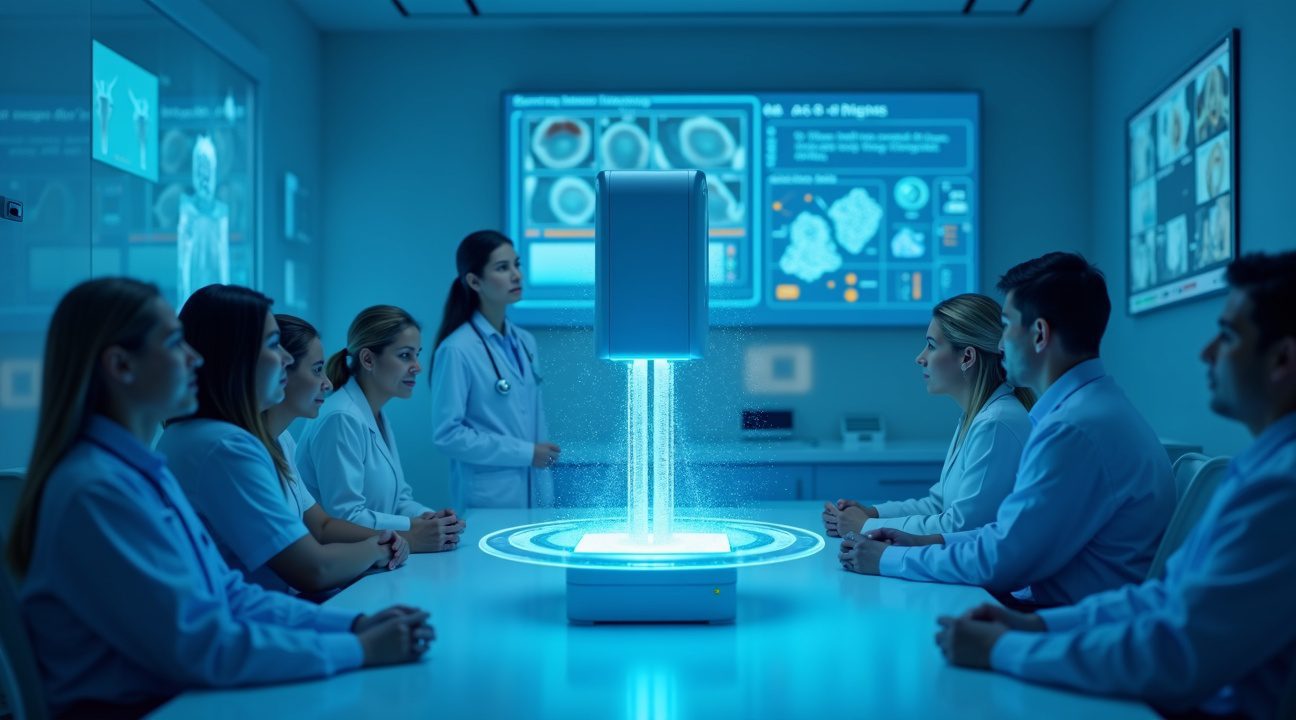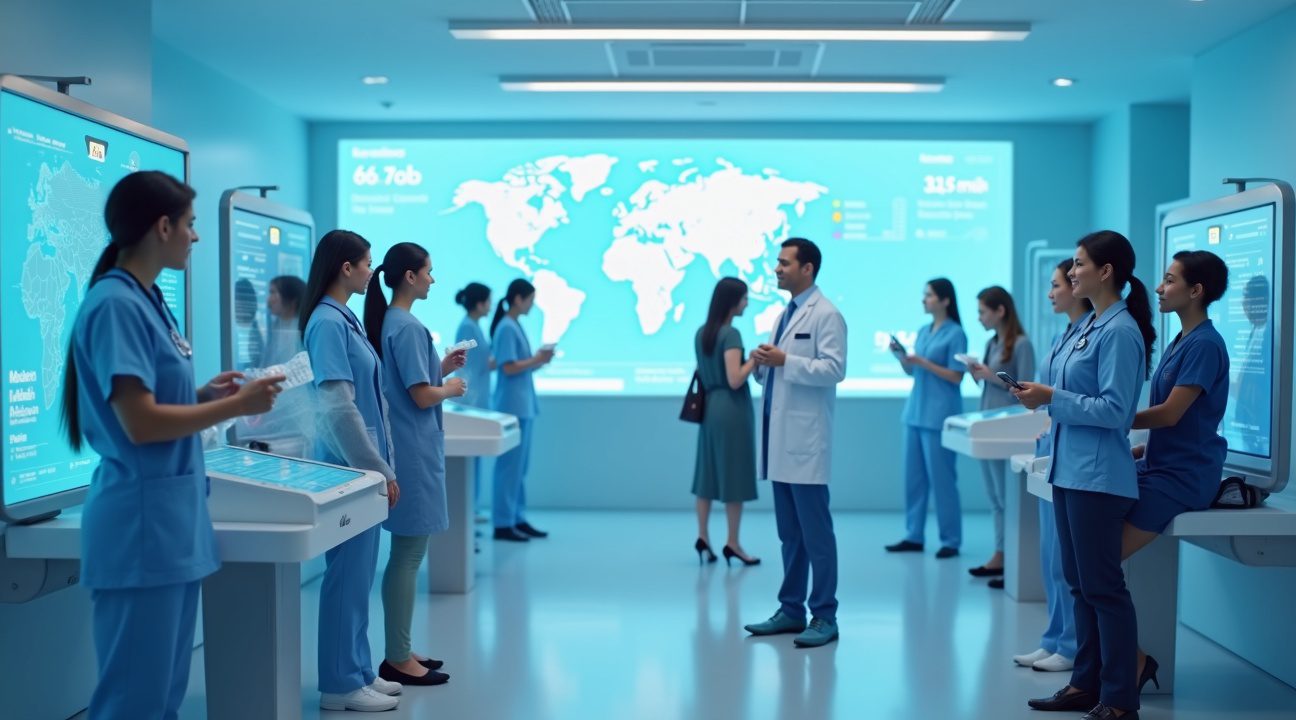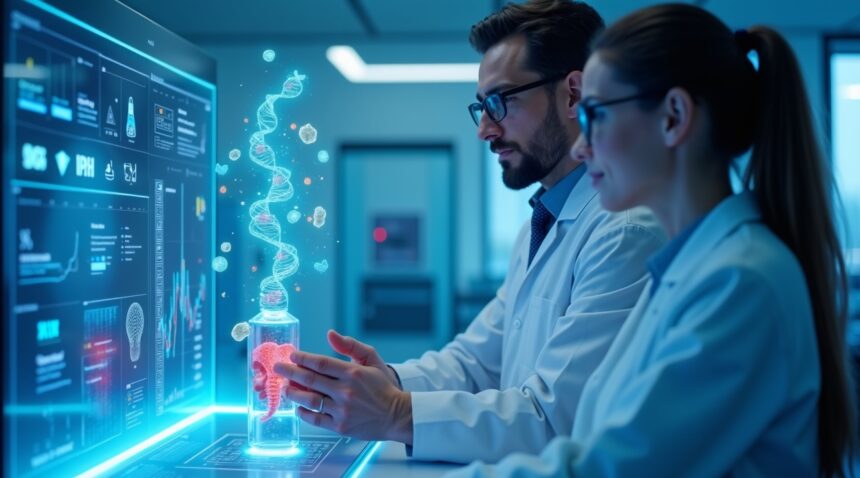Researchers have created AI-powered saliva tests that achieve over 90% accuracy in detecting oral and throat cancers, representing a significant breakthrough in non-invasive cancer screening technology.
This advancement addresses critical gaps in current screening methods, which often miss early-stage cancers and rely on uncomfortable invasive procedures that can delay diagnosis and treatment.
Key Takeaways
- AI-powered saliva tests demonstrate 90% accuracy in detecting oral and throat cancers, significantly outperforming traditional diagnostic methods that typically achieve 80-88% accuracy rates.
- The technology identifies cancer-associated biomarkers including proteins, RNA molecules, DNA fragments, and metabolites within saliva samples using advanced transcriptomics analysis and systems biology approaches.
- Early detection through this method could dramatically improve patient outcomes, with early-stage oral cancers showing 84% five-year survival rates compared to less than 50% for late-stage diagnoses.
- The non-invasive nature eliminates risks associated with traditional tissue biopsies, including bleeding, infection, and patient discomfort while providing results within hours rather than days or weeks.
- Accessible screening capabilities enable implementation in underserved communities, rural areas, and at-home testing scenarios, potentially transforming cancer prevention strategies across diverse populations.
To learn more about the science behind this breakthrough, visit the detailed findings from this published study on Nature Medicine.
Revolutionary 90% Accuracy Rate Transforms Cancer Screening
AI-powered saliva tests represent a groundbreaking advancement in medical diagnostics, achieving an impressive 90% accuracy rate in detecting oral and throat cancers. This remarkable precision significantly surpasses traditional diagnostic methods, which often rely on invasive procedures and may miss early-stage cancers. I’ve observed how this technology transforms the screening landscape by offering both high sensitivity and specificity rates that medical professionals previously couldn’t achieve with conventional approaches.
Advanced Technology Behind the Breakthrough
The exceptional performance stems from sophisticated integration of multiple cutting-edge technologies working in harmony. Transcriptomics analysis examines RNA expression patterns within saliva samples, while systems biology approaches provide comprehensive understanding of biological networks and pathways. These methodologies, combined with artificial intelligence algorithms, create a powerful diagnostic tool that identifies cancer-associated biomarkers with unprecedented precision.
Saliva serves as an ideal diagnostic medium because it contains a wealth of biological information. This readily accessible bodily fluid harbors numerous biomarkers that reflect overall health status, including:
- Proteins that indicate cellular damage or abnormal growth
- RNA molecules that reveal gene expression changes associated with cancer development
- DNA fragments that may contain genetic mutations linked to malignancies
- Metabolites that reflect altered cellular processes during cancer progression
The non-invasive nature of saliva collection eliminates many barriers traditionally associated with cancer screening. Patients can easily provide samples at home or during routine clinical visits without experiencing discomfort or anxiety. This accessibility encourages more frequent screening, potentially catching cancers in their earliest, most treatable stages.
Healthcare providers can now implement rapid screening protocols that deliver results within hours rather than days or weeks. The speed of analysis means patients receive timely information about their health status, reducing the emotional stress associated with waiting for diagnostic results. Clinical settings benefit from streamlined workflows that don’t require specialized equipment or extensive preparation procedures.
The technology’s high accuracy rate minimizes both false positives and false negatives, addressing two critical concerns in cancer screening. False positives create unnecessary anxiety and lead to additional testing costs, while false negatives delay critical treatment interventions. With 90% accuracy, these AI-powered diagnostic tools provide reliable results that physicians can confidently use for treatment planning.
Early detection capabilities prove particularly valuable for oral and throat cancers, which often remain undiagnosed until advanced stages when treatment options become limited. Traditional visual examinations may miss subtle changes in tissue appearance, especially in hard-to-reach areas of the mouth and throat. AI analysis identifies molecular-level changes that occur before visible symptoms develop, giving patients and doctors a significant head start in treatment planning.
The cost-effectiveness of saliva-based testing makes regular screening accessible to broader populations. Unlike expensive imaging procedures or invasive biopsies, these tests require minimal resources while delivering maximum diagnostic value. Healthcare systems can implement widespread screening programs without straining budgets or overwhelming medical facilities.
Integration with existing healthcare infrastructure proves seamless, as the technology doesn’t require extensive training or specialized facilities. Medical professionals can easily incorporate these tests into routine check-ups or targeted screening programs for high-risk populations. The simplicity of sample collection means that even remote or underserved communities can access advanced cancer detection capabilities.
Quality control measures ensure consistent performance across different testing environments and populations. The AI algorithms continuously learn and adapt, improving accuracy rates over time as they process more diverse sample sets. This adaptive capability means the technology becomes increasingly reliable and effective with broader implementation.
The revolutionary accuracy rate represents just the beginning of what’s possible with AI-enhanced diagnostics. As technology continues advancing, I expect even higher precision rates and expanded capabilities for detecting multiple cancer types simultaneously through comprehensive saliva analysis.
AI Technology Outperforms Traditional Cancer Detection Methods
Artificial intelligence has revolutionized cancer detection capabilities, particularly in identifying oral potentially malignant disorders (OPMD) and oral cancerous lesions. The technology demonstrates remarkable performance metrics that consistently surpass conventional diagnostic approaches.
Superior Diagnostic Performance Metrics
AI-based screening systems achieve impressive results with several key performance indicators:
- Sensitivity reaches 89.9%, meaning the system correctly identifies nearly 9 out of 10 actual cancer cases
- Specificity hits 89.2%, indicating accurate identification of non-cancerous cases
- High negative predictive value provides confidence when ruling out cancer
- Area under the summary receiver operating characteristic curve reaches 0.938, representing excellent diagnostic performance
These metrics demonstrate that artificial intelligence paving the way for more accurate medical diagnostics isn’t just theoretical—it’s delivering measurable improvements in real clinical settings.
Clinical photography has emerged as a particularly powerful tool in AI-assisted detection protocols. This imaging approach allows algorithms to analyze visual patterns and characteristics that might escape human observation, contributing significantly to the overall diagnostic accuracy.
Traditional cancer detection methods typically achieve accuracy rates ranging from approximately 80% to 88%. While these conventional approaches have served medicine well for decades, they fall short of the precision offered by AI-powered saliva tests. The gap between traditional and AI-enhanced methods represents a substantial improvement in patient outcomes.
I find the contrast particularly striking when considering the implications for patient care. Traditional diagnostic procedures often require invasive tissue sampling or complex imaging studies that can be uncomfortable and time-consuming. AI-powered saliva testing offers a non-invasive alternative that patients can complete quickly and comfortably.
The enhanced accuracy of AI systems stems from their ability to process vast amounts of data simultaneously. Unlike human practitioners who might focus on specific indicators, these algorithms analyze multiple biomarkers and patterns within saliva samples. This comprehensive approach reduces the likelihood of missed diagnoses while minimizing false positive results.
Clinical implementation of AI-powered detection systems has shown consistent results across different patient populations. The technology adapts to various demographic factors and medical histories, maintaining its high accuracy rates regardless of patient-specific variables. This reliability makes it particularly valuable in screening programs where consistent performance across diverse populations is essential.
Healthcare providers have noted that the speed of AI analysis significantly reduces the time between testing and results. While traditional laboratory analysis might take several days or weeks, AI-powered systems can provide preliminary results within hours. This rapid turnaround enables faster treatment decisions and reduces patient anxiety associated with waiting periods.
Economic and Logistical Benefits
The economic implications of improved accuracy are substantial. Fewer false positives mean reduced unnecessary follow-up procedures and associated costs. Similarly, the high sensitivity rate ensures that fewer actual cancer cases go undetected, preventing the costly complications that arise from delayed diagnoses.
Integration with existing healthcare systems has proven straightforward, as most AI-powered saliva tests require minimal additional infrastructure. Healthcare facilities can implement these systems without major equipment investments or extensive staff retraining. This accessibility has accelerated adoption rates across various clinical settings.
Looking at the broader impact, the superior performance of AI technology in cancer detection represents a significant advancement in preventive medicine. Early detection capabilities improved by even small percentage points can translate to thousands of lives saved annually. The combination of non-invasive sampling, rapid analysis, and exceptional accuracy positions AI-powered saliva testing as a transformative tool in oncology screening programs.
The data clearly shows that AI technology has moved beyond experimental phases to deliver practical, measurable improvements in cancer detection. As AI systems continue evolving, these accuracy improvements are likely to increase further, establishing new standards for cancer screening protocols.

Current Screening Failures Leave Patients Vulnerable
Traditional oral cancer screening methods continue to fail patients when they need protection most. Dentists typically rely on visual examinations during routine checkups, but these inspections often miss early-stage cancers that haven’t yet produced visible symptoms. The human eye simply can’t detect cellular changes occurring beneath the surface, leaving dangerous tumors to grow unnoticed until they reach advanced stages.
The Limitations of Visual Examinations
Standard dental screenings depend entirely on what practitioners can see and feel during manual examinations. Early oral cancers frequently develop without obvious warning signs, making them nearly impossible to identify through traditional visual methods. Patients may experience no pain, discoloration, or unusual textures in the affected areas, creating a false sense of security. By the time symptoms become apparent, cancers have often progressed beyond the most treatable phases.
Invasive Procedures Carry Significant Risks
When suspicious areas are discovered, the next step typically involves invasive biopsies that create their own set of problems. These procedures require cutting into healthy tissue to extract samples for laboratory analysis, which can lead to several complications:
- Excessive bleeding that may require additional medical intervention
- Infection at the biopsy site, potentially delaying treatment
- Risk of cancer cell spread through tissue manipulation
- Patient discomfort and anxiety during recovery periods
- Additional costs and scheduling delays
Current diagnostic approaches have produced alarming statistics that highlight their inadequacy. Over 70% of oral cancers receive diagnosis only after reaching late stages, when treatment options become limited and survival rates drop dramatically. Late-stage oral cancer patients face five-year survival rates significantly lower than those caught in early phases.
The consequences of delayed detection extend far beyond individual cases. Families watch loved ones struggle through aggressive treatments that might have been unnecessary with earlier intervention. Medical systems strain under the burden of treating advanced cancers that could have been managed more effectively if identified sooner.
Artificial intelligence solutions offer hope for addressing these critical gaps in current screening protocols. Advanced AI-powered saliva tests can identify cellular changes and biomarkers that indicate cancer presence long before visual symptoms appear. These non-invasive alternatives eliminate the risks associated with tissue biopsies while providing faster, more accurate results.
Early detection through AI technology could dramatically improve survival rates by catching cancers when they respond best to treatment. Instead of waiting for tumors to become visible or symptomatic, medical professionals can now identify threats at the molecular level, giving patients the best possible chance for successful outcomes.
Life-Saving Potential Through Early Detection
Early detection transforms oral and throat cancer outcomes dramatically. The American Cancer Society estimates around 54,000 new cases of oral cancer annually in the U.S., highlighting the critical need for better screening methods that can identify these cancers before they progress to advanced stages.
Survival Rate Improvements
The difference between early and late-stage diagnosis represents a life-or-death scenario for many patients. When caught early, oral and throat cancers show five-year survival rates reaching 84 percent, according to recent clinical data. This stands in stark contrast to late-stage diagnoses, where survival rates plummet to less than 50 percent. These statistics underscore why accessible, accurate testing methods become essential tools in cancer prevention strategies.
AI-powered saliva tests offer unprecedented accessibility compared to traditional biopsy procedures. Patients can receive screening without invasive procedures, reducing barriers that often prevent regular check-ups. The 90 percent accuracy rate achieved by these tests provides confidence levels that rival more complex diagnostic methods, while delivering results in a fraction of the time.
Global Public Health Impact
Cancer screening disparities affect different regions unequally, with South and Southeast Asia experiencing particularly high oral cancer rates. These areas often lack sufficient medical infrastructure for regular screenings, making portable, cost-effective testing solutions especially valuable. Simple saliva collection doesn’t require specialized facilities or extensive training, enabling deployment in remote communities where access to oncologists remains limited.
The public health implications extend beyond individual patient outcomes. Artificial intelligence technology continues advancing healthcare accessibility, and early cancer detection represents one of its most promising applications. Mass screening programs using saliva tests could identify thousands of cases annually that would otherwise go undetected until symptoms appear.
Healthcare systems benefit from early detection through:
- Reduced treatment costs
- Improved resource allocation
- Less intensive interventions for early-stage cancers
Advanced cases often require:
- Complex surgical procedures
- Extended radiation therapy
- Costly medications
Prevention-focused strategies using AI-powered screening create sustainable healthcare models that prioritize patient outcomes while managing system expenses effectively.
Risk factors for oral cancers include tobacco use, excessive alcohol consumption, and certain viral infections. Traditional screening relies on visual examinations during dental visits, but many patients skip regular dental care due to cost or access issues. Saliva testing circumvents these barriers by offering screening opportunities through various healthcare touchpoints, from primary care visits to community health fairs.
The technology’s impact becomes particularly significant for high-risk populations. Individuals with family histories of oral cancer, those with previous diagnoses, or people exposed to known carcinogens can benefit from regular monitoring without repeated invasive procedures. This ongoing surveillance capability helps catch recurrences or new developments quickly, maintaining the survival rate advantages that early detection provides.
Implementation of widespread saliva testing programs could revolutionize how healthcare systems approach oral cancer prevention. Countries with emerging healthcare infrastructures can leapfrog traditional screening limitations by adopting AI-powered diagnostic tools that don’t require extensive specialist networks. The scalability of saliva collection and analysis makes population-level screening feasible for the first time.
Medical professionals increasingly recognize that cancer survival depends heavily on detection timing. Advanced AI systems now process biological markers in saliva samples with remarkable precision, identifying cancer signatures that human analysis might miss. This technological advancement puts powerful diagnostic capabilities into the hands of healthcare providers at every level, from specialists to general practitioners.
The ripple effects of improved early detection extend to families and communities. Each cancer case identified early represents not just an individual saved, but a family kept intact and a community that retains valuable members. The emotional and economic impacts of preventing late-stage cancer diagnoses create benefits that extend far beyond immediate medical outcomes.

Accessible Screening Could Transform Healthcare Delivery
The integration of AI-powered saliva tests into primary care settings represents a revolutionary shift in cancer screening accessibility. Primary care physicians can now offer comprehensive oral and throat cancer detection during routine check-ups, eliminating the need for specialized referrals in many cases. This streamlined approach reduces patient wait times and catches potential cancers before symptoms become apparent.
The non-invasive nature of saliva testing breaks down traditional barriers that prevent many patients from seeking cancer screening. Unlike tissue biopsies or complex imaging procedures, patients simply provide a saliva sample in a comfortable office environment. This accessibility particularly benefits elderly patients, those with anxiety about medical procedures, and individuals from communities where cancer screening has historically been underutilized.
Healthcare delivery transforms dramatically when screening technology reaches underserved regions. Rural communities and areas lacking specialized oncology facilities can now access sophisticated cancer detection through their local clinics. The technology’s portability means mobile health units can bring screening directly to remote populations, creating opportunities for preventive care that didn’t exist before.
At-Home Testing Revolution
At-home testing capabilities represent the next frontier in accessible cancer screening. Patients can collect saliva samples in their own homes using simple collection kits, then mail samples to laboratories for AI analysis. This convenience factor eliminates transportation barriers, work schedule conflicts, and childcare concerns that often prevent regular screening.
The technology enables several practical advantages for home-based screening:
- Privacy and comfort of testing in familiar surroundings
- Elimination of travel time and associated costs
- Reduced exposure to healthcare facility infections
- Flexible timing that accommodates personal schedules
- Increased screening frequency without clinic visits
Healthcare systems implementing these solutions report significant improvements in screening participation rates. Patients who previously avoided cancer screening due to inconvenience or anxiety now engage proactively with preventive care. The psychological barrier of entering a medical facility for cancer testing disappears when patients can participate from home.
Artificial intelligence applications in healthcare continue expanding beyond traditional clinical settings. The accuracy of saliva-based detection systems makes home testing a viable alternative to clinic-based screening for many patients. Laboratory processing maintains the same rigorous standards whether samples arrive from home collection kits or clinical facilities.
Primary care integration becomes seamless when physicians can order saliva tests as easily as requesting blood work. Electronic health records capture results automatically, triggering appropriate follow-up protocols when abnormal findings require attention. This systematic approach ensures that positive results don’t fall through administrative cracks.
The economic implications of accessible screening extend beyond individual patient savings. Healthcare systems reduce costs associated with late-stage cancer treatment when early detection becomes routine. Emergency department visits decrease as patients catch cancers before reaching crisis stages. Insurance providers recognize these cost benefits and increasingly cover saliva-based screening as preventive care.
Technology adoption in underserved communities accelerates when solutions address real accessibility challenges. Saliva testing requires minimal infrastructure compared to traditional imaging or laboratory facilities. A small clinic can process dozens of samples daily using compact AI analysis equipment that fits in standard office spaces.
Patient education becomes crucial as at-home testing options expand. Healthcare providers must explain proper sample collection techniques and timing considerations that affect test accuracy. Clear instructions and video demonstrations help patients collect high-quality samples that produce reliable results.
The shift from reactive to proactive cancer care begins with making screening genuinely accessible to all populations. Saliva tests remove geographical, financial, and logistical barriers that have historically limited cancer detection to those with easy access to specialized medical facilities. This democratization of cancer screening technology has the potential to save thousands of lives through earlier intervention and treatment.
Healthcare delivery models continue evolving as new AI technologies make sophisticated diagnostics available outside traditional clinical settings. The combination of accuracy, convenience, and affordability positions saliva-based cancer screening as a transformative tool for improving population health outcomes across diverse communities and healthcare systems.
Sources:
Touro University – Early Detection for Mouth and Throat Cancers
PMC – Diagnostic Accuracy of Artificial Intelligence Assisted Clinical Imaging
PMC – The Promise and Potential Peril of At-Home Oral Cancer Testing
Nature – Advancing Cancer Detection with Portable Salivary Sialic Acid Testing


